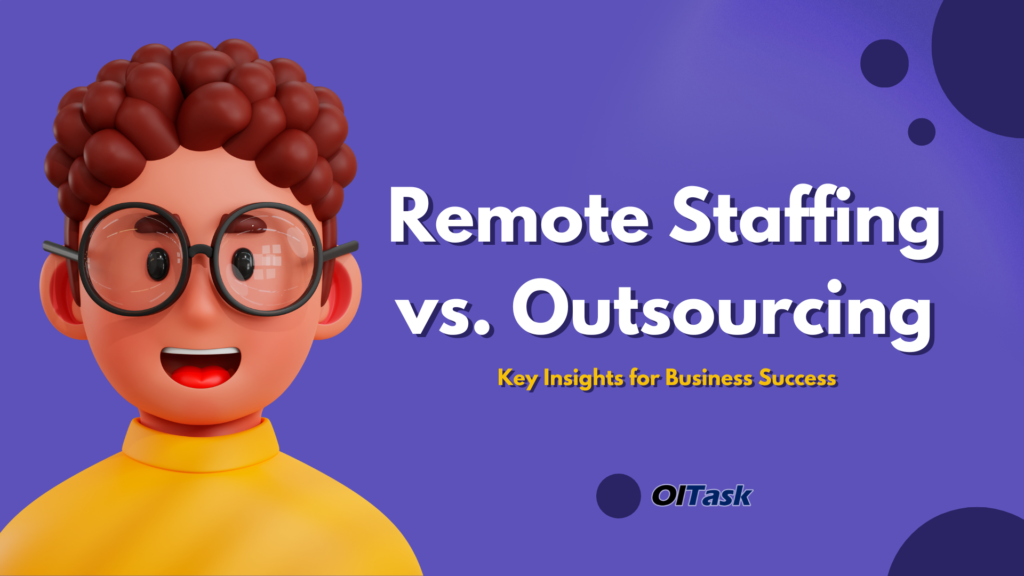Remote Staffing vs Outsourcing: Key Insights for Business Success

Today’s dynamic business environment highlights the differences between remote staffing vs outsourcing on a whole new level. Nowadays, choosing between the two has to be done as strategically as possible, since your choice will impact the growth of your company significantly. For businesses particularly focused on e-commerce and SaaS, making the right choice between the two is crucial.
Scroll down to know everything you need before you make that pivotal choice.
Understanding the Key Differences in Remote Staffing vs Outsourcing

Understanding the key differences between remote staffing and outsourcing is crucial for businesses to make informed decisions about their workforce strategy. These two models, while similar in utilizing off-site work, differ significantly in terms of control, integration, and the nature of the work relationship.
Remote Staffing: Integration and Control
Remote staffing involves hiring individuals who, though they work remotely, are considered employees or part of your team. They are integrated into your company’s culture and directly contribute to your business processes.
- Direct Management: Remote staff are managed directly by your internal teams, similar to in-house employees. This management style allows for greater control over the work process and output.
- Cultural Alignment: Remote employees are immersed in and contribute to the company culture, aligning with the company’s values, goals, and practices. This fosters a sense of belonging and commitment.
- Skill Specialization: Remote staffing is particularly useful when you need specialized skills that are not available locally. You can hire the best talent from a global pool who work exclusively for your company.
- Employee Development: Investing in the growth and development of remote staff is common, as they are seen as long-term assets to the company. This includes training, career advancement opportunities, and performance evaluations.
Outsourcing: Specialization and Efficiency
Outsourcing involves contracting a third-party organization or independent contractors to handle certain business functions or projects. The outsourced provider manages these operations, offering specialized expertise.
- Third-party Management: In outsourcing, the external provider manages the teams who perform the work. This setup reduces direct control but can bring in specialized management skills.
- Project or Function-Specific: Outsourcing is often used for specific projects or business functions, such as customer service, IT support, or accounting. It’s especially beneficial for non-core activities that an external provider can perform more efficiently.
- Cost Efficiency: Typically, outsourcing can be more cost-effective, particularly for short-term projects. The business pays for the service without the long-term financial commitments associated with hiring employees.
- Flexibility and Scalability: Outsourcing offers the flexibility to scale up or down based on project needs without the complexities of hiring or layoffs.
Hybrid Approach: Combining Both Models
Many businesses find value in a hybrid approach, utilizing both remote staffing and outsourcing for different aspects of their operations. For example, core functions like product development might be handled by remote employees, while non-core functions like customer support are outsourced.
The Role of Remote Staffing in Modern Businesses
Remote staffing is particularly effective for operations that require close alignment with a company’s internal team, such as customer support, technical roles, and creative tasks. This approach offers the flexibility to scale the workforce according to current business needs and maintains a consistent company culture, even in a remote work setting.
For a deeper understanding of how remote staffing can optimize your sales strategy, check out our piece on Prospecting Sales.
Comparing Costs: Remote Staffing vs Outsourcing Cost
When evaluating remote staffing vs outsourcing costs, several factors come into play, each impacting the overall financial strategy of a business.
- Remote Staffing Costs: Involves expenses akin to traditional employment, such as salaries, benefits, and the technology infrastructure to support remote work. However, it saves significantly on physical workspace and related overheads.
- Outsourcing Costs: Often presents a more variable cost structure. While it can offer lower initial costs, particularly for specialized projects, there can be additional fees for customization or changes beyond the initial scope.
Long-Term Financial Implications
When comparing remote staffing and outsourcing, businesses must consider several long-term financial implications. These implications can significantly affect a company’s budget, resource allocation, and overall financial strategy. Here’s an in-depth look at these considerations:
Employee Costs vs. Service Costs
- Remote Staffing: Hiring remote employees involves similar costs to hiring on-site staff. This includes salaries, benefits, taxes, and potentially, costs associated with remote work setups (like home office equipment). Over the long term, these costs can be substantial, but they also come with an investment in employee development and loyalty.
- Outsourcing: With outsourcing, the costs are structured as payments for services rendered. This typically includes a contract fee, which may be fixed or variable depending on the project. While this can be lower in the short term, costs may fluctuate based on the scope of work and can increase if additional services are required.
Training and Development
- Remote Staffing: Continuous training and professional development are integral to maintaining a skilled remote workforce. This ongoing investment contributes to better job performance but adds to long-term costs.
- Outsourcing: Training costs are generally borne by the outsourcing provider. The business pays for the service, not the development of the individuals providing it. While this saves costs, it may lead to a dependency on the outsourcing provider for specialized skills.
Operational Control and Efficiency
- Remote Staffing: Increased control over remote employees can lead to more efficient operations aligned with business goals. This can improve long-term financial performance, though it requires an upfront investment in management and communication systems.
- Outsourcing: While outsourcing offers less operational control, it can lead to short-term efficiency gains, especially in non-core areas. However, the lack of control can also result in inefficiencies if the provider’s goals and methods don’t align with the business’s.
Quality of Work and Output
- Remote Staffing: Directly hired remote staff are more likely to be committed to the company’s success, potentially leading to higher-quality work and output. This alignment can drive long-term revenue growth and customer satisfaction.
- Outsourcing: The quality of outsourced work can vary, and there might be concerns about the provider’s understanding and commitment to the company’s objectives. While it can be cost-effective, inconsistent quality might impact long-term business performance.
Legal and Compliance Costs
- Remote Staffing: Businesses must comply with labor laws and regulations in the jurisdictions where remote employees reside. This can incur legal and administrative costs.
- Outsourcing: Compliance is generally the responsibility of the outsourcing provider. However, businesses still need to ensure that outsourced operations comply with industry standards and regulations, especially in sensitive areas like data security.
Scalability and Flexibility
- Remote Staffing: Scaling a remote team can be more time-consuming and costly, as it involves recruiting and training new employees.
- Outsourcing: Outsourcing offers more flexibility to scale operations quickly based on business needs, which can be financially advantageous in adapting to market changes.
Strategic Benefits and Challenges

Choosing between remote staffing vs outsourcing involves weighing their respective benefits and challenges.
- Remote Staffing: Offers more control over staff training and development, leading to a more cohesive team environment. However, it requires robust management and communication tools to ensure productivity and engagement.
- Outsourcing: Provides access to immediate expertise and can be scaled quickly according to project needs. The challenge lies in ensuring the outsourced team aligns with the company’s standards and objectives.
To explore the nuances of outsourcing sales operations, take a look at our blog on Outsourcing Sales.
Making the Right Choice for Your Business
In the final analysis, the decision between remote staffing vs outsourcing should be guided by your business’s specific needs, goals, and the nature of the tasks at hand.
- For tasks that require tight integration with your team and adherence to company culture, remote staffing is likely the more suitable option.
- For specialized projects or when needing specific expertise not available in-house, outsourcing may be the more efficient choice.
Integrating Remote Staffing into Your Business Model
Embracing remote staffing involves more than just hiring remote workers; it’s about integrating them into your business culture and processes. This integration requires:
- Effective Communication Tools: Implementing robust technology solutions for seamless collaboration.
- Cultural Alignment: Ensuring remote staff understand and embrace your company values.
- Performance Management: Establishing clear metrics and regular check-ins to monitor and support remote staff productivity.
Building a Remote-First Culture
Building a remote-first culture is a critical endeavor for businesses that embrace remote staffing as their primary operational model. This approach involves more than just allowing employees to work from home; it’s about creating an organizational culture and operational framework where remote work is the norm, not the exception. In this context, let’s delve deeper into how companies can build a remote-first culture.
Embracing a Remote-First Mindset
- Shifting the Paradigm: Transitioning to a remote-first culture requires a fundamental shift in mindset from leadership to every team member. It means thinking about work in terms of objectives and output, rather than hours spent in an office.
Creating an Inclusive and Collaborative Environment
- Fostering Inclusion: In a remote-first environment, it’s crucial to ensure that all employees, whether they are sourced through a “remote staffing agency” or hired directly, feel equally valued and included. Regular team meetings, virtual social events, and open communication channels can help foster a sense of belonging and community.
- Collaborative Tools: Utilize collaboration tools that allow remote workers to interact seamlessly. Platforms like Slack, Microsoft Teams, and Trello can aid in maintaining clear and consistent communication across different projects and teams.
Reimagining Workspaces and Work Practices
- Home Office Setup: Support “remote staffing work from home” setups by providing guidelines on creating an effective workspace. Companies can also offer stipends for home office equipment to ensure employees have a comfortable and productive environment.
- Asynchronous Work: Encourage asynchronous working methods where possible. This approach respects different time zones and personal working styles, allowing for flexibility while maintaining productivity.
Prioritizing Communication and Transparency
- Regular Check-ins: Establish regular check-ins and updates. This could be in the form of daily stand-ups, weekly team meetings, or monthly all-hands meetings, depending on the size and nature of the team.
- Transparent Processes: Ensure that all processes, from onboarding new employees to executing projects, are transparent and well-documented. This clarity is essential in remote settings to avoid confusion and miscommunication.
Investing in the Right Technology
- Tech-Enabled Infrastructure: Invest in a robust technological infrastructure that supports remote work. This includes reliable internet access, cloud-based tools, and cybersecurity measures.
- Training on Tools: Regularly train staff on how to use these tools effectively, ensuring everyone is comfortable and proficient in the digital environment.
Cultivating Trust and Accountability
- Trust-Based Approach: Cultivate a culture of trust where employees feel empowered to manage their own time and workload. Trust is a cornerstone of successful remote-first cultures.
- Clear Expectations and Accountability: Set clear expectations regarding deliverables and deadlines. While flexibility is key in remote work, accountability ensures that team goals are consistently met.
Encouraging Continuous Learning and Development
- Professional Growth: Promote continuous learning and professional development. This can be facilitated through online courses, webinars, and virtual workshops, ensuring that employees have opportunities to grow and develop in their “remote staffing jobs.”
Focusing on Employee Well-Being
- Well-being Initiatives: Pay special attention to the mental and physical well-being of remote employees. Implement initiatives like virtual wellness sessions, mental health days, and regular check-ins to ensure employees are not feeling isolated or burnt out.
Measuring Performance and Gathering Feedback
- Performance Metrics: Develop performance metrics that reflect the remote-first environment. Focus on outcomes and quality of work rather than traditional metrics like time spent at the desk.
- Regular Feedback: Regularly seek feedback from employees on how to improve the remote working experience. Being responsive to employee needs and suggestions is vital in a remote-first culture.
Outsourcing as a Strategic Business Lever

Outsourcing, when used strategically, can be a powerful tool for business growth. This approach is particularly effective for:
- Accessing Specialized Skills: Outsourcing to agencies with specific expertise, like SEO services or technical support.
- Managing Seasonal Fluctuations: Utilizing outsourcing to handle temporary increases in workload.
- Cost Reduction: Leveraging outsourcing for non-core activities can lead to significant cost savings.
Partnering with the Right Outsourcing Agency
Partnering with the right outsourcing agency is a strategic decision that can significantly impact the success of your business operations. To ensure a fruitful collaboration, consider the following key factors:
Alignment with Business Needs
- Understand Your Requirements: Clearly define what you need from an outsourcing agency, whether it’s expertise in a specific field, capacity for large-scale projects, or the ability to work within certain timeframes.
- Specialization: Look for an agency that specializes in the services you require, be it customer support, IT services, or digital marketing. Specialized agencies are more likely to deliver high-quality results.
Reputation and Track Record
- Check References and Reviews: Research the agency’s past performance and client feedback. Testimonials, case studies, and online reviews can provide insights into their reliability and quality of work.
- Experience in Your Industry: An agency experienced in your industry will have a better understanding of your challenges and requirements.
Communication and Collaboration
- Effective Communication: Ensure the agency has effective communication channels. Miscommunication can lead to unsatisfactory results and delays.
- Collaboration Approach: The agency should be collaborative and proactive in its approach, willing to integrate with your internal teams seamlessly.
Cost vs. Value
- Transparent Pricing: Look for clear and upfront pricing to avoid hidden costs. Cheaper options aren’t always the most cost-effective in the long run.
- Value for Money: Consider the value the agency brings through its services, not just the cost. The cheapest option might not always offer the best return on investment.
Scalability and Flexibility
- Ability to Scale: Choose an agency that can scale its services up or down based on your business needs. This flexibility is crucial for adapting to market changes or business growth.
- Flexibility in Services: The agency should be adaptable in its services, offering customized solutions rather than a one-size-fits-all approach.
Success Stories in Remote Staffing and Outsourcing

To illustrate the practical implications of remote staffing vs outsourcing, let’s look at some success stories:
- E-commerce Giants Leveraging Remote Staffing: Leading e-commerce platforms now utilize remote staffing to build a global customer service team. This approach allows them to offer 24/7 support, increasing customer satisfaction and loyalty.
- Outsourcing for Technological Advancement: SaaS companies outsource their software development to specialized tech agencies. Such a partnership enables them to accelerate product development with cutting-edge expertise, significantly reducing their time-to-market.
These examples underscore the tangible benefits that can be achieved through strategic staffing decisions.
Balancing Remote Staffing and Outsourcing for Optimal Results
Many businesses find that a blend of both remote staffing and outsourcing works best. This hybrid approach allows companies to maintain control over core functions while benefiting from external expertise for specialized tasks.
- Core Functions: Utilize remote staffing for roles that are central to your business operations.
- Specialized Projects: Outsource projects that require niche skills or are outside your core competencies.
Creating a Seamless Workflow
Creating a seamless workflow in a remote environment is essential for maintaining efficiency and ensuring smooth operations. This involves integrating the right tools, clear communication, and streamlined processes.
- Implementing the Right Tools: Utilize comprehensive digital tools for communication, project management, and document sharing. Tools like Slack or Microsoft Teams for communication, Asana or Trello for task management, and Google Drive or Dropbox for file sharing are essential. These tools should be easy to use and accessible to all team members.
- Streamlining Communication: Establish clear communication channels and protocols. Regular virtual meetings and check-ins can help keep everyone aligned. Use video conferencing for team meetings and instant messaging for quick questions or updates. Clear guidelines on which tools to use for different types of communication (urgent vs. non-urgent, internal vs. external) are important.
- Standardizing Processes: Develop standard operating procedures (SOPs) for routine tasks and workflows. This ensures consistency and efficiency, with everyone understanding their roles and responsibilities. Documenting these processes also helps in onboarding new team members.
- Task Management and Prioritization: Implement a system for tracking and managing tasks. This could involve a shared digital calendar, a project management tool, or regular progress reports. Prioritize tasks based on urgency and importance, ensuring that team members focus on the right tasks at the right time.
- Feedback and Continuous Improvement: Regularly solicit feedback from team members on workflow effectiveness. Be open to making adjustments based on this feedback to continually improve processes.
Future Trends in Remote Staffing and Outsourcing
Looking ahead, several trends are likely to shape the future of remote staffing and outsourcing:
- Increased Automation: The integration of AI and automation tools in both remote staffing and outsourcing will enhance efficiency and productivity.
- Global Talent Pools: As remote work becomes more normalized, businesses will have access to an even wider global talent pool.
- Focus on Security and Compliance: With the rise of remote work, ensuring data security and compliance with international regulations will become increasingly important.
Preparing for the Future
To stay ahead, businesses should continuously evaluate and adapt their staffing strategies in line with these emerging trends.
As businesses navigate the evolving terrain of remote staffing and outsourcing, preparing for the future becomes paramount. This preparation involves anticipating trends, embracing technology, and fostering adaptability. Here are key strategies for businesses to effectively prepare for the future:
Embracing Technological Advancements
Technology is a driving force in the evolution of remote staffing and outsourcing. Businesses must:
- Invest in Advanced Tools: Utilize cutting-edge tools for communication, project management, and productivity. AI and machine learning can automate routine tasks, freeing up human resources for more complex work.
- Cybersecurity Measures: As remote work increases, so does the risk of cyber threats. Implementing robust cybersecurity protocols is essential to protect sensitive data and maintain business integrity.
- Cloud Computing: Leveraging cloud services ensures that your team, whether in-house, remote, or outsourced, has secure and efficient access to necessary data and applications.
Building a Flexible and Resilient Workforce
The future workforce needs to be adaptable, with skills that align with evolving business needs.
- Continuous Learning and Development: Encourage and facilitate continuous skill development for employees. This might include online courses, workshops, and cross-training opportunities.
- Cultivating a Culture of Adaptability: Create a work environment where change is not just expected but embraced. This involves encouraging innovative thinking and being open to new ways of working.
- Diversifying Talent Acquisition: Look beyond traditional hiring methods and geographies. Embrace a global talent pool to bring diverse perspectives and skills to your team.
Strategic Planning and Agile Methodologies
Adopting an agile approach in strategic planning allows businesses to be more responsive to market changes.
- Flexible Business Models: Develop business models that can quickly adapt to changing market conditions. This might involve diversifying revenue streams or creating modular service offerings.
- Scenario Planning: Regularly engage in scenario planning to anticipate potential challenges and opportunities. This involves envisioning various future scenarios and developing strategies to address them.
- Fostering Collaboration: Encourage collaboration between different departments and teams, including remote and outsourced personnel, to foster innovation and agile response to changes.
Focusing on Sustainability and Social Responsibility
As societal expectations shift, businesses must focus on sustainability and social responsibility.
- Sustainable Practices: Implement environmentally friendly practices, whether in remote work policies or in the choice of outsourcing partners.
- Ethical Outsourcing: Ensure that outsourcing partners adhere to ethical practices, including fair labor practices and environmental responsibility.
- Community Engagement: Engage with the communities in which you operate, whether locally or globally. This can build goodwill and a strong brand reputation.
Leveraging Data and Analytics
Data is a critical asset in understanding and preparing for future trends.
- Data-Driven Decisions: Use data analytics to inform business decisions, from market trends to workforce management.
- Predictive Analytics: Utilize predictive analytics to anticipate market shifts, customer behavior changes, and operational needs.
- Performance Metrics: Regularly review and adapt performance metrics for both in-house and outsourced teams to ensure alignment with evolving business goals.
Recruiting and Onboarding Remote Staff
Finding and integrating new remote employees into the team poses its own set of challenges.
- Effective Online Recruitment Processes: Leverage digital platforms for recruitment, including social media, professional networks, and online job boards.
- Comprehensive Virtual Onboarding: Create a detailed onboarding process that includes virtual meet-and-greets, training sessions, and regular check-ins.
- Buddy System: Pair new hires with more experienced employees to help them navigate the company culture and work processes.
Navigating the Remote Staffing vs Outsourcing Landscape
The choice between remote staffing vs outsourcing depends on various factors, including your business needs, the nature of the work, and cost considerations. By understanding the strengths and limitations of each approach, you can make informed decisions that bolster your business’s growth and adaptability in the digital age.
Don’t let the complexities of remote staffing and outsourcing hinder your business’s potential. Discover the ease and efficiency with OlTask, your gateway to expertly managed remote staffing solutions. Whether you’re grappling with building a seamless workflow, establishing a remote-first culture, or navigating the intricacies of global talent acquisition, OlTask is here to streamline your journey. Embrace the future of work with confidence.